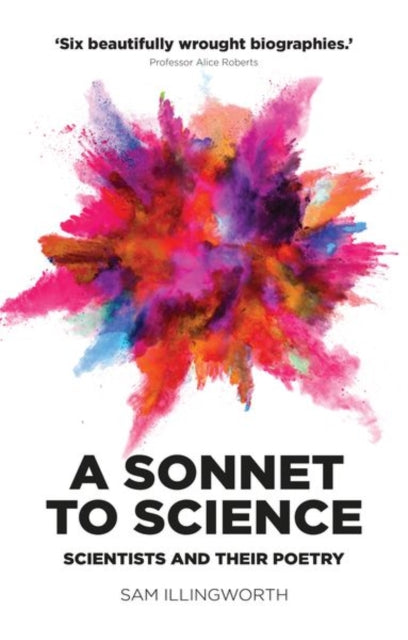Sam Illingworth
Sonnet to Science: Scientists and Their Poetry
Sonnet to Science: Scientists and Their Poetry
YOU SAVE £2.15
- Condition: Brand new
- UK Delivery times: Usually arrives within 2 - 3 working days
- UK Shipping: Fee starts at £2.39. Subject to product weight & dimension
Bulk ordering. Want 15 or more copies? Get a personalised quote and bigger discounts. Learn more about bulk orders.
Couldn't load pickup availability
- More about Sonnet to Science: Scientists and Their Poetry
A sonnet to science presents an account of six ground-breaking scientists who also wrote poetry, and the effect that this had on their lives and research. It aims to inspire current and future generations of scientists and poets to see these worlds as complementary rather than mutually exclusive.
Format: Hardback
Length: 224 pages
Publication date: 31 May 2019
Publisher: Manchester University Press
A sonnet to science explores the fascinating intersection of six groundbreaking scientists who not only excelled in their respective fields but also possessed a poetic spirit. Through their literary endeavors, these individuals not only enriched their personal lives but also left a lasting impact on their scientific research. In this captivating narrative, we delve into the profound influence that poetry had on their creative processes and intellectual journeys.
One of the key themes that emerges is the inspiration drawn from Lord Byron. Byron's poetic prowess and his profound understanding of the human condition deeply resonated with these scientists, leading them to incorporate poetic elements into their scientific writings. For instance, the universal computer, a concept that emerged in the early 20th century, was greatly influenced by Byron's vision of a machine that could process and analyze vast amounts of information. The scientists, in their quest to create a machine that could mimic human intelligence, found inspiration in Byron's portrayal of the power of the mind and the potential for machines to emulate it.
Another intriguing aspect of the sonnet to science is the way in which the link between malaria and mosquitos was first captured in the form of a poem. In the late 19th century, scientists were grappling with the mystery of how malaria was transmitted. It was a disease that plagued millions of people worldwide, and yet the cause remained elusive. However, it was a young poet named William Blake who, through his poetic vision, shed light on the connection between the mosquito and the disease. Blake's poem "The Tyger" vividly depicted the fierce and relentless nature of the mosquito, which served as a metaphor for the disease's spread. This poetic insight not only helped scientists understand the mechanics of malaria transmission but also inspired them to develop new strategies for prevention and control.
Humphry Davy, another prominent scientist in the sonnet to science, is often referred to as an "illiterate pirate." Despite his lack of formal education, Davy's contributions to the field of chemistry were groundbreaking. He was a pioneer in the development of the safety lamp, a device that revolutionized the mining industry by reducing the risk of explosions. However, Davy's unconventional approach to science and his disregard for traditional academic conventions often led him to be viewed as a misfit by his peers. In the sonnet to science, we explore the complex relationship between Davy and his colleagues, highlighting the tension between his poetic spirit and his scientific achievements.
The sonnet to science serves as a powerful testament to the symbiotic relationship between science and poetry. It demonstrates how these two disciplines can complement and inspire each other, leading to new insights and breakthroughs. By exploring the lives and works of these six groundbreaking scientists, the book encourages current and future generations of scientists and poets to embrace the power of interdisciplinary collaboration. It reminds us that the boundaries between these two worlds are not fixed, but rather fluid and open to exploration.
In conclusion, A sonnet to science is a captivating exploration of the intersection of science and poetry. Through its vivid narratives and insightful analysis, the book sheds light on the profound influence that poetry can have on scientific inquiry. It serves as a reminder that these two disciplines are not mutually exclusive but rather complementary in nature, and that by working together, we can achieve greater heights of creativity and discovery. Whether you are a scientist or a poet, this book will inspire and challenge you to think beyond the boundaries of your respective fields and embrace the power of interdisciplinary collaboration.
Weight: 406g
Dimension: 148 x 224 x 20 (mm)
ISBN-13: 9781526127983
This item can be found in:
UK and International shipping information
UK and International shipping information
UK Delivery and returns information:
- Delivery within 2 - 3 days when ordering in the UK.
- Shipping fee for UK customers from £2.39. Fully tracked shipping service available.
- Returns policy: Return within 30 days of receipt for full refund.
International deliveries:
Shulph Ink now ships to Australia, Belgium, Canada, France, Germany, Ireland, Italy, India, Luxembourg Saudi Arabia, Singapore, Spain, Netherlands, New Zealand, United Arab Emirates, United States of America.
- Delivery times: within 5 - 10 days for international orders.
- Shipping fee: charges vary for overseas orders. Only tracked services are available for most international orders. Some countries have untracked shipping options.
- Customs charges: If ordering to addresses outside the United Kingdom, you may or may not incur additional customs and duties fees during local delivery.


